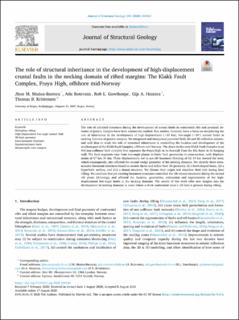The role of structural inheritance in the development of high-displacement crustal faults in the necking domain of rifted margins: The Klakk Fault Complex, Frøya High, offshore mid-Norway
Munoz Barrera, Jhon Meyer; Rotevatn, Atle; Gawthorpe, Rob; Henstra, Gijs Allard; Kristensen, Thomas Berg
Journal article, Peer reviewed
Published version

View/
Date
2020-08-20Metadata
Show full item recordCollections
- Department of Earth Science [1103]
- Registrations from Cristin [10402]
Abstract
The role of inherited structures during the development of normal faults in continental rifts and proximal domains of passive margins have been extensively studied. Few studies, however, have a focus on deciphering the role of inheritance in the development of high-displacement (>10 km), low-angle (<30°) normal faults in necking domains of passive margins. We integrated and interpreted potential field, 2D and 3D reflection seismic, and well data to study the role of structural inheritance in controlling the location and development of the southern part of the Klakk Fault Complex, offshore mid-Norway. The down-to-the-west Klakk Fault Complex is an N-S non-collinear fault complex that separates the Frøya High in its footwall from the Rås Basin in its hanging wall. The fault segments vary from low-angle planar to listric fault geometries in cross-section, with displacements of 17 km–34 km. These displacements led to syn-rift basement thinning of 12–14 km toward the west, which consequently, also affected the crustal wedge geometry of the necking domains. We identify three intra-acoustic-basement structures based on seismic facies and define their 3D geometry: (i) a bowl-shaped basin, (ii) a hyperbolic surface, and (iii) a domal structure. We discuss their origin and elucidate their role during later rifting. We conclude that pre-existing basement structures controlled the rift-related structures during the second rift phase (thinning), and affected the location, geometries, orientation and segmentation of the high-displacement low-angle faults in the necking domains. The results of this work offer new insights into the development of necking domains in areas where a thick continental crust (>25 km) is present during rifting.
